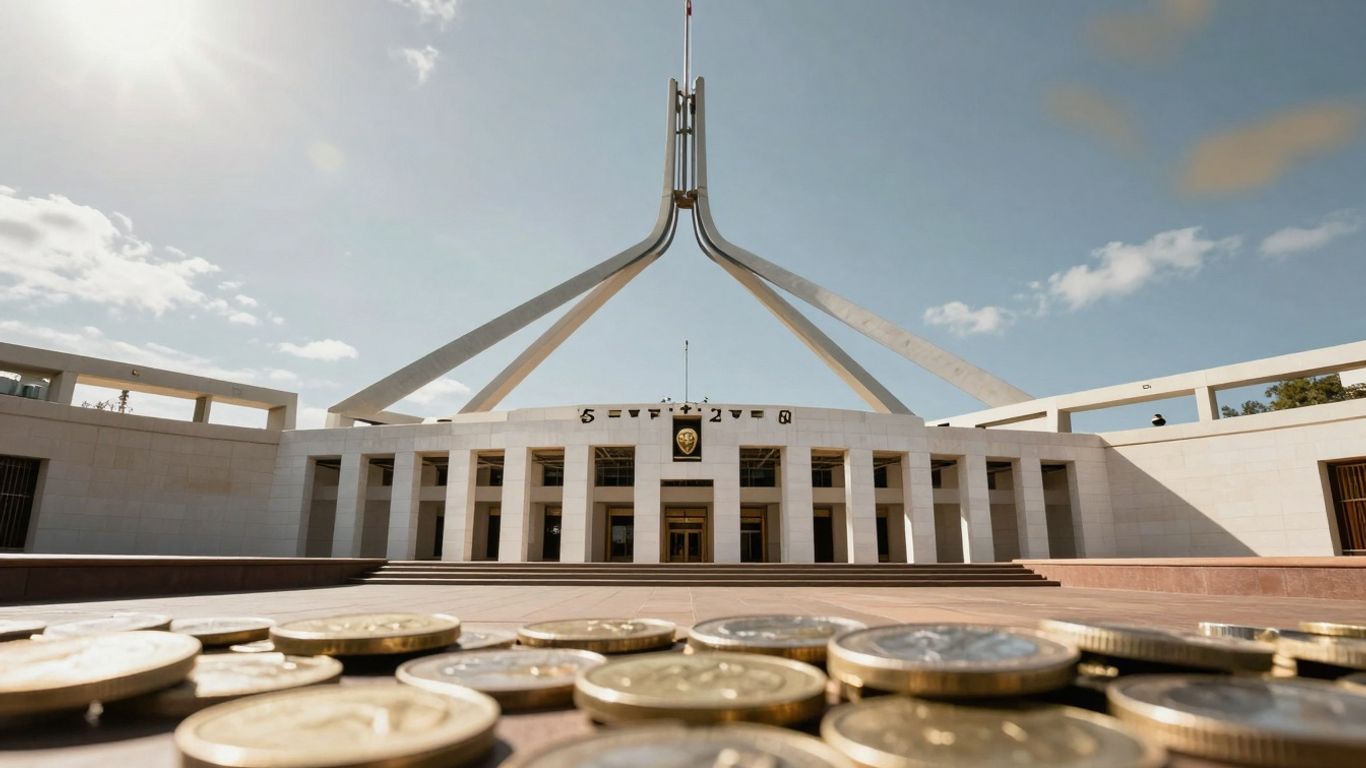Thinking about where to put your money in 2025? Australian investments are changing fast, and it’s not just about shares or property anymore. People are looking at everything from green energy to new digital tools, and the government is rolling out fresh policies all the time. Younger Aussies are jumping in, especially with tech and sustainable options, while old favourites like property and private equity are still on the table. Whether you’re just starting out or have been investing for years, knowing what’s happening now can help you make better choices for the future.
Key Takeaways
- Economic signs like GDP, jobs, and lending are shaping where Australians put their money.
- Eco-friendly and ESG investments are getting more popular, with help from government incentives.
- Property is shifting—regional areas and new rental models are catching investors’ eyes, not just city units.
- Digital tools, robo-advisors, and investment apps are making it easier for everyday people to get involved.
- Private equity, venture capital, and new sectors like tech, defence, and health are creating fresh opportunities—but every choice comes with its own risks.
Australian Investments Driven by Key Economic Indicators
Australian investment strategies in 2025 are changing with the ups and downs of a few key metrics. People are watching things like economic growth, job data, and household spending closer than ever, because these numbers can shift market moods fast.
Investor Confidence and Participation Trends
There’s been a definite push in investor activity, especially among younger Australians. More than 1.1 million people now manage their own super funds, keeping nearly $900 billion in SMSFs. Investor confidence was strong at the end of last year – about 79% – which led to a dramatic 50% rise in IPOs for the ASX, shooting up to 67 new listings. There’s also a big move towards ETFs, with the local market expected to climb past $300 billion.
Investors today fall mainly into three groups:
- Millennials and Gen Z, who are fuelling most new retail and business accounts.
- Self-directed investors, who increasingly prefer managing their own portfolios.
- Institutionals, chasing new sectors like data centres and tech.
Many Aussies are feeling empowered to take control of their investments, yet they’re still keeping an eye on more traditional markers of market health.
Impact of GDP and Employment Data on Markets
It’s no secret that Australia’s overall economic health sets the tone for investors. In late 2024, the country’s GDP was up by 1.3% year-on-year. Employment figures have held up well, which keeps consumer confidence ticking along. New lending, especially for housing, jumped by 14.2% – not a small number, and it’s triggered a reaction across several investment classes.
Here’s a basic snapshot of some recent data (late 2024–early 2025):
| Indicator | Recent Value | Trend |
|---|---|---|
| GDP Growth (YoY) | 1.3% | Steady |
| Employment Rate | 96–97% | Stable |
| Lending for New Dwellings | +14.2% | Rising |
| Capital Expenditure | $155.9bn | Marginal Up |
Investors are keeping tabs on these figures to get a sense of where risks and chances might be hiding for the months ahead.
Role of Lending and Retail Turnover in Shaping Portfolios
Retail turnover and lending patterns have a direct effect on which sectors get picked in Aussie investment portfolios. When people borrow more to buy homes or businesses spend on equipment, it signals positive expectations for growth. Retail trade figures and household spending give another clue – if Australians are spending more, companies see bigger profits, which often results in share price moves.
Current signs for 2025:
- Increased lending and retail spending hint at stronger economic growth.
- Young adults account for most new business investments, especially in retail and services.
- Sectors linked to consumer activity and lending (like banks, retail, and construction) are set to see more action in portfolios.
Everyday spending, rising wages, and ongoing home loans are putting some wind in the sails of both the stock market and real estate. The big trick for investors this year is reading these signals right, and not getting caught up in short-term noise.
Sustainable Growth: Environmental and ESG Trends in Australian Investments
Australia’s investment scene is shifting fast, with sustainability now front and centre. Investors are not just chasing returns; they want to see their money doing good – especially when it comes to climate and social issues. From green bonds to government subsidies, there’s a growing sense that investing in Australia means thinking green in 2025.
ESG Strategies and Green Bonds
ESG (Environmental, Social, and Governance) strategies are shaping how Australians build and adjust their portfolios. Companies and funds that score highly on ESG factors are attracting more capital as Australians pay greater attention to social responsibility.
- Green bonds are on the rise, letting investors back eco-friendly initiatives like renewable energy and low-emission transport.
- Superannuation funds now routinely include ESG screens before picking stocks or bonds.
- Private and public clean energy funds are pooling capital to support everything from giant wind farms to sustainable agriculture.
Here’s a quick table showing investment types and their main ESG characteristics:
| Investment Type | ESG Focus | Typical Projects |
|---|---|---|
| Green Bonds | Environmental | Solar farms, battery storage |
| ESG Equity Funds | Environmental/Social | Clean tech firms, healthcare |
| Clean Energy Funds | Environmental | Wind, solar, energy efficiency |
Australian investors are using these tools to support projects aligned with updated emissions reduction targets.
Government Incentives for Renewable Energy
Australia’s federal and state governments are keen on pushing renewable energy, providing strong incentives that encourage both big investors and everyday Aussies.
- Targeted tax credits and grants are making solar, wind, and battery projects far more attractive.
- Credits for electric vehicles and energy-efficient housing are opening new doors for retail and institutional investors.
- Clear emissions reduction goals give the whole energy sector a kind of certainty it didn’t have a few years ago, encouraging longer-term commitments from funds and companies.
- Carbon pricing tools are shifting more capital into clean and green assets.
With more policy stability around renewable projects, investors and companies seem less afraid to jump in and back new ideas.
Risks and Challenges in Sustainable Investing
No investment is without risk, and sustainable options have their own unique set of issues to watch.
- Greenwashing: Some companies still exaggerate their ESG credentials, making it hard to spot authentic projects.
- High upfront costs: Renewable energy infrastructure needs a lot of initial capital, which can be a hurdle for some investors.
- Policy changes: Changing government incentives or environmental regulations could suddenly alter the investment landscape.
- Market volatility: Energy prices and supply chain hiccups can add uncertainty to what might otherwise look like a safe bet.
Australian investors are learning to balance strong ESG ambitions with a clear-eyed approach to risk. Many now prefer to spread their capital across both established clean energy firms and new eco-friendly projects, seeking a mix of stability and growth as ESG continues to evolve.
Property Market Shifts Redefining Australian Investments

Australia’s property market is never boring, but 2025 is shaping up to throw in more surprises. Investors are thinking beyond the standard approach as new models take hold, regional areas gain momentum, and infrastructure changes the map yet again.
Rise of Regional and Build-to-Rent Models
Pack your bags, city slickers aren’t the only winners anymore. Regional towns are calling, thanks to affordable housing, changing work habits, and that post-pandemic urge for space. Build-to-rent, which was once barely a thing here, is finding its legs. These projects let investors own entire developments designed just for renting, offering a steadier income and a unique way to play the market.
- Increased demand in places previously considered "too far out"
- Lower buying costs, but sometimes higher rental yields in regional hotspots
- Young renters and people priced out of major cities fuelling the build-to-rent movement
Residential Versus Commercial Returns
Not all bricks and mortar bring the same reward. Here’s a quick side-by-side recap of how residential and commercial real estate stack up for investors in 2025:
| Feature | Residential | Commercial |
|---|---|---|
| Lease Length | 6–12 months | 3–10 years |
| Vacancy Rate (avg.) | 1.0% | 13.7% (CBD avg.) |
| Risk | Generally lower | Higher, less stable |
| Entry Price | Lower | Higher |
| Yield Potential | Lower | Higher |
| Suitability | Most investors | Experienced, cashed-up |
- Residential: better if you want steady demand and easy entry.
- Commercial: can mean higher cash flow, but trickier tenant search and longer periods between tenants.
- Tax can get more complicated with commercial (think GST, different deductions).
More Aussies are considering mixing both residential and commercial holdings just to spread out risk and keep options open for different returns.
Infrastructure Developments Boosting Property Value
If there’s a new train line or a road planned in your neighbourhood, you just might be sitting on a future goldmine. Major upgrades—like Melbourne’s Suburban Rail Loop or Sydney Metro West—are raising demand for nearby properties, bumping up values and making off-the-plan investments more tempting.
- Transport and connectivity projects open up new suburbs for growth.
- Urban renewal makes less-popular areas newly attractive.
- Early investors using platforms like Coposit or options like buying off-the-plan are positioning themselves for long-term gains.
It’s not just a house—sometimes, where it sits and what’s being built nearby turns a routine investment into something special.
Digital Transformation in the Australian Investment Landscape
The investment world in Australia is changing faster than most of us expected. It’s no longer just financial advisors in city offices—everyone, from students to retirees, can join the action right from their phone or laptop. Digital innovation is making this happen, shaking up traditional ways of investing and giving way to more control and flexibility for regular Australians.
Growth of Robo-Advisors and Automated Platforms
Robo-advisors and automated platforms are getting more popular every year, mainly because they’re easy to use and don’t need big starting balances. These smart tools ask a few questions about your finances, then set up investment strategies for you—sometimes in just a few minutes. For many Australians, robo-advisors mean they can invest without the stress of picking individual stocks or funds.
Some benefits of these digital helpers include:
- Quick setup and onboarding
- Transparent fees without hidden surprises
- Continued portfolio updates as markets move
Before, only big investors got access to tax-efficient strategies or wide diversification. Now, robo-platforms bring these features straight to everyone, which is why so many new investors are joining the market.
Integration of Digital and Traditional Strategies
More people are combining these digital tools with good old-fashioned advice from real humans. It turns out, blending both can offer the best of both worlds—tech handles the maths and routine, while humans jump in for complex situations.
| Approach | What It Offers |
|---|---|
| Digital Platforms | Cost-effective, fast, easy |
| Human Advisers | Tailored advice, experience |
| Hybrid Models | Flexibility, balance |
A well-integrated approach makes it easier to update strategies when markets shift. For example, combining robo-advice with DIY trading and, if needed, consulting a professional can lead to smarter decisions—especially as
new technologies keep changing how people interact with the market. The rapid evolution in managed services, as seen in cloud-based digital platforms, is one reason for the push toward integrated investment solutions in Australia.
Accessibility and Security on Investment Apps
It’s not just about who can invest; it’s also about how safe it is. Security features are front-and-centre, with most apps using features like two-factor authentication and encrypted data to protect users. Fees are mostly upfront, with leading platforms staying transparent. Also, most apps are easy to browse—swipe, tap, and your trade is done.
When comparing Australian investing apps, users often look for:
- Strong privacy controls
- Simple interfaces
- Regular security updates
Whether you’re just starting out or have been investing for decades, digital advancements mean the process is more inclusive and secure than ever. The doors are open wider, and there’s a platform for nearly every kind of investor out there.
The growing role of digital platforms is shaping investment choices across the country, making Australian markets feel more accessible, safer, and a bit more user-friendly for all sorts of investors.
The Expanding Role of Private Equity and Venture Capital in Australia
Private equity and venture capital are moving into the mainstream of Australian investing, pushing past the boundaries of public markets. This shift is drawn by the need for fresh growth opportunities, particularly as broader economic swings have made investors re-examine where real value lies.
Sector Hubs: Technology, Health, and Fintech
The focus for both private equity and venture deals is tightening around a few high-growth sectors:
- Technology: AI, software-as-a-service (SaaS), and digital transformation firms are magnets for capital.
- Healthcare: Medtech startups and innovative health service providers are seeing large funding rounds.
- Fintech: Startups in payment systems, lending tech, and compliance tools keep pulling investor attention.
Venture funding in 2024 mostly clustered around these three sectors, and this pattern is set to persist.
| Sector | Share of VC/PE Deals (2024) | Expected Growth (2025) |
|---|---|---|
| Technology | 46% | High |
| Healthcare | 22% | Steady |
| Fintech | 18% | High |
| Other | 14% | Moderate |
Startups in these areas can go from small to major players rapidly, but the competitive pressure is intense and many will not reach the next stage.
Access Points for Individual Investors
It used to be that you needed significant capital or exclusive connections to enter the private equity or start-up world. In 2025, it’s getting easier, but the landscape is still tricky:
- Managed Funds: Various super funds and investment platforms are starting to add private market options for retail investors.
- Crowdfunding: Equity crowdfunding platforms let ordinary people invest with smaller parcels, sometimes from $250.
- Syndicates and Co-investment: Groups of investors pool resources to access opportunities too expensive for individuals.
Opportunities and Risks in Alternative Asset Classes
Private equity and venture investments can bring higher returns, but they come with their own batch of risks:
- Long lock-in periods: Your money could be tied up for years, with no guarantee of early exit.
- Opaque pricing: Unlisted markets don’t have clear price signals — it’s tough to know your asset’s real value.
- Business failure risk: Especially high in start-ups; more fail than succeed.
The hunt for higher gains means growing comfort with risk and accepting less liquidity.
Anyone considering private assets should weigh their risk tolerance and understand there’s no quick cash-out option if things go south.
Emerging Sectors Fueling the Next Generation of Australian Investments

Australia’s investment landscape in 2025 looks pretty different from what it was a few years back. The main opportunities are showing up in a handful of sectors—technology, defence and infrastructure, and healthcare innovation. Here’s a closer look at what’s powering the next wave of local investments.
Technology Advancements and AI Integration
It feels like everywhere you go, someone’s talking about AI or automation. Technology is the engine behind a lot of business growth and investment activity in Australia right now.
- AI is getting built into everything from banking to healthcare, boosting productivity and creating whole new business models.
- Australian tech companies—especially in fintech and cybersecurity—are seeing a flood of venture capital and private equity.
- AI isn’t just for big firms. Startups focused on AI-powered services are popping up in most major cities, and investors are paying attention.
| Area | Top Subsector | 2025 Growth Projection |
|---|---|---|
| Fintech | Digital Payments | +15% YoY |
| AI Services | Health Diagnostics | +20% YoY |
| Cybersecurity | Threat Detection Tools | +13% YoY |
The tech boom is opening doors for regular investors through ETFs and digital platforms, levelling the playing field and letting more people in on the action.
Defence and Infrastructure Spending
Defence budgets have grown sharply, and it’s impacting more than just traditional military companies. You’ve got a ripple effect across different industries:
- Telecommunications – rolling out secure networks.
- Industrial and materials firms – supplying equipment and raw materials.
- Cybersecurity and logistics – keeping tech and supply chains running safely.
This, paired with major infrastructure projects (new roads, transport upgrades, energy systems), means more jobs, bigger contracts, and renewed business activity in sectors that were once considered pretty dull.
Healthcare Innovation and Biotech Growth
This sector’s been fighting for attention for a while, but now investors are finally tuning in. The use of AI is helping companies:
- Speed up drug discovery
- Make diagnostics more accurate
- Customise medical devices to individual needs
You’ve got big players like CSL and Cochlear leading the charge, but smaller biotechs are also building strong partnerships, mostly looking to get products to market faster by working with data science firms.
Investors should watch:
- Companies involved in medtech or smart devices (think AI-powered hearing aids and sleep therapy)
- Fast-growing biotech startups, particularly those working with universities
- Healthcare ETFs, which saw record inflows in early 2025
| Company | Area | 2025 Focus |
|---|---|---|
| Cochlear | Medical Devices | AI Signal Processing |
| CSL | Biotech | Drug Development |
| ResMed | Digital Health | AI Sleep Solutions |
Smart investments in tech, defence, and health aren’t just trendy—they’re tied to long-term population needs and future government strategies, making them worth a closer look for anyone thinking about where to put their money next.
Maximising Returns Through Diversification and Modern Portfolio Strategies
Diversification isn’t just an old investment buzzword—it’s still one of the simplest and most reliable ways for Australians to manage uncertainty in 2025. The trend now is for everyday investors to blend both classic assets and newer instruments into a single portfolio, using modern digital tools to keep costs down and risk in check. The smartest portfolios today actively balance risk, cost, and opportunity, never leaning too hard on any one market or approach.
Low-Cost Investing and ETF Trends
The popularity of low-cost investments has taken off, especially with ETFs. These funds are all about broad access at a fraction of the usual expense:
- ETFs track indices like the ASX 200, letting you hold bits of hundreds of companies in one single place.
- Fees can be as little as 0.1% a year, compared to old-school funds charging much more.
- Investors can pick sector-specific ETFs, including tech, healthcare, and even green energy.
| Type of Investment | Average Management Fee | Liquidity | Typical Diversification |
|---|---|---|---|
| Managed Fund | 0.8% – 1.5% | Moderate | Medium to High |
| Indexed ETF | 0.1% – 0.5% | High | Very High |
| Individual ASX Stock | None | High | Low |
Wide adoption of ETFs has made it possible to build a strong, diversified portfolio even with modest starting funds—there’s simply no need to focus on picking individual shares anymore.
Rebalancing and Managing Risk Effectively
Risk isn’t about dodging losses altogether, but picking how much and what kind you’re actually willing to take. Portfolios tend to drift over time, so rebalancing matters:
- Check your overall mix (shares, bonds, property, cash) at least once or twice per year.
- Shift assets back to your original balance—sell some winners, buy more laggards.
- Keep an eye on costs and timing to avoid triggering unnecessary tax bills.
This sort of hands-on maintenance keeps you aligned with your real goals and stops any single asset from dominating after a hot streak, which can happen especially with sharp cycles in coastal property prices.
Professional Guidance for Optimising Outcomes
Not everyone wants to go it alone—and that’s sensible. A financial adviser can run through your situation and:
- Suggest tax tactics to hang on to more of your return.
- Help structure your super and investments for long-term plans (like early retirement or children’s education).
- Offer a second pair of eyes on risk and big-picture market shifts.
You don’t need to be wealthy to get real value from expert advice. Even a one-off session can clear up doubts, fine-tune your plan, and point out overlooked risks or opportunities.
Diversification, smart use of cost-effective products, and regular check-ins—plus a little outside input—set the scene for solid returns while keeping surprises in check, now and into 2025.
Conclusion
Looking ahead to 2025, the Australian investment scene is changing fast. There’s a lot happening—new tech, a bigger focus on clean energy, and more young people getting involved through digital platforms. Property is still a big deal, but now there are more ways to invest, like ETFs and even private equity if you’re up for it. It’s not all smooth sailing, though. The economy can shift, and government rules keep changing, so it pays to keep an eye on what’s going on. If you’re thinking about where to put your money, spreading it out and staying flexible seems to be the way to go. And remember, what worked last year might not work next year, so don’t be afraid to get advice or tweak your plan. In the end, there’s no one-size-fits-all answer, but with a bit of patience and some research, there are plenty of chances to grow your wealth in Australia’s future.
Frequently Asked Questions
What are the main investment trends in Australia for 2025?
In 2025, Australians are focusing on digital investing, sustainable choices, and new sectors like technology and healthcare. More people are using online platforms and robo-advisors to manage their money. Investments in green energy and ESG (Environmental, Social, and Governance) are also growing quickly.
Why is sustainable investing becoming so popular in Australia?
Sustainable investing is getting more attention because people want their money to help the environment and society. The government offers rewards for investing in clean energy, and more companies are creating green bonds. But it’s important to watch out for companies that only pretend to be green.
How is technology changing the way Australians invest?
Technology is making investing easier and safer. Robo-advisors and investment apps let people start with small amounts and see their money grow in real time. These tools also help keep your information safe and make investing simple for beginners.
What is the difference between investing in property and shares in Australia?
Property investing usually means buying homes or buildings to rent out or sell later. Shares are parts of companies you can buy and sell on the stock market. Property can give steady rent, while shares can grow or fall in value quickly. Both have risks and rewards, so many people choose to do both.
Are Exchange-Traded Funds (ETFs) a good option for new investors?
Yes, ETFs are popular because they spread your money across many companies or sectors, which lowers risk. They are easy to buy and sell, and usually have low fees. This makes them a smart choice for people starting out with investing.
What should I remember before making any investment in 2025?
Always remember that past results don’t promise future success. Every investment has risks, and it’s important to check your choices carefully. If you’re not sure, talk to a financial adviser who can help you find the best plan for your goals.





